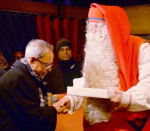 This is a truly great book. It shines a historian’s expert light on a truly important topic for all. It is upbeat, in keeping with the impressive strides presently being made by India, by discovering cases of Hindu resourcefulness even in the darkest episodes. – Dr. Koenraad Elst
This is a truly great book. It shines a historian’s expert light on a truly important topic for all. It is upbeat, in keeping with the impressive strides presently being made by India, by discovering cases of Hindu resourcefulness even in the darkest episodes. – Dr. Koenraad Elst
“Hindustan” was a Persian geographical term for the land beyond the Sindhu/Indus, and still is. It is synonymous with Bharat, the subcontinent. This won’t assuage the hostile observers who suspect a dirty anti-secular secret whenever an Indian leader calls this country Hindustan. “Hindu”, by contrast, did acquire a religious meaning when the Muslim invaders brought into India “any Indian unbeliever”. The expression “Hindus of Hindustan” plays upon the tension between these two meanings.
Dr. Meenakshi Jain, formerly with Delhi University and with the Nehru Memorial Museum and Library, is one of India’s most meritorious and productive—I had almost written ‘eminent’—historians. Of both Rama and Krishna, she has given clear answers about their historicity and the many unsuspected ramifications of their afterlife as popular gods. In documenting and analysing specialised historical themes, from sati to the Hindus’ resourceful defence against iconoclasm, she has few rivals and nothing to prove anymore. But her new book, The Hindus of Hindustan: A Civilizational Journey (Aryan Books, 2023), deals with a very general theme on which many opinion makers are also having their say. How does she hold up here?
On the much-discussed matter of Indian national unity’s ancientness, she gives a fair estimation, better referenced than nationalist or anti-national pamphlets. She proves it beyond doubt that the political goal of unifying the whole subcontinent was not a British phenomenon.
Phrases like “They came and were conquered” (p.148, about the assimilation of invaders like Greek Heliodorus into Vaishnavism, Kushana Kanishka into Buddhism or Huna Mihirakula into Shaivism) could figure in the history overview of any tourist guidebook. But when finding a cliché correct, she also adds examples that no layman has heard about. Thus, pin-pricking a secularist claim, she shows that in India, religiously committed rulers did without persecuting other religions, e.g. Brahminical Satavahanas sponsored Buddhism, Jain Kalachuris patronised Shaivism, etc (p.111).
There is now a wealth of material evidence for the Vedic character of the Harappan cities, which she updates and enlivens with numerous visual illustrations. Thus, fire altars have been found not just in the region of Vedic composition but as far south as Lothal in coastal Gujarat. (p.78-80) Many archaeologists now agree with the late B.B. Lal that “Vedic and Harappan are two sides of the same coin”.
Then there is the continuity from the Harappan civilisation into the Epic and Puranic ages. For some lesser-known examples, she draws attention to the continuity between Harappan and Mauryan worship of trees and pillars, or between Mohenjo Daro’s “priest-king” and the iconography of Mahavira and the Buddha (p.82).
The painful chapter of the Islamic invasions, which did not result in an idyllic assimilation, also had to be addressed. A number of Muslim historians are quoted as clearly telling the tale that Hindus are expected to shut up about. (Here I must warn her that sometimes she cites texts in Orientalist translation. Not that the Leftist historians have ever shown a significant mistake in these, but they are bound to allege that “Dr Jain holds fast to colonial myths”.) The first Sanskrit inscription reporting on an Arab invasion is from ca. 730 (p.234); as usual, she quotes the primary source.
The author keeps perspective by emphatically adding a presentation of the many instances of Hindu resistance. Contrary to a colonial stereotype, the Hindus didn’t take it lying down. In the end, they even reconquered most of Hindustan.
This is a truly great book. And it is eminently fit to serve as a present in the coming festive season: not a dour textbook hyperfocused on a topic appealing only to her colleagues, but shining a historian’s expert light on a truly important topic for all. It is upbeat, in keeping with the impressive strides presently being made by India, by discovering cases of Hindu resourcefulness even in the darkest episodes. For the benefit of the not-so-reading-minded consumer, it is also visually very rich. Yet these photographs of Hindustan’s achievements don’t reduce it to a parlour-table book: they are integrated into a grand project of serving up correct and up-to-date history. – News18, 1 Septemeber 2023
› Dr. Elst is a well-known historian, linguist and indologist from Belgium.
Filed under: india | Tagged: book review, hindu civilisation, hindustan, indian history, meenakshi jain | Comments Off on Book Review: The Hindus of Hindustan: A Civilizational Journey – Koenraad Elst



























